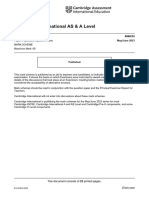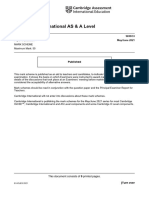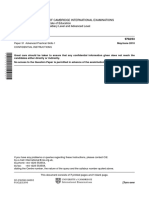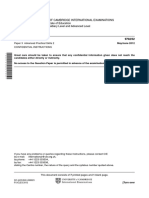Cambridge International AS & A Level: Sociology 9699/22 March 2020
Cambridge International AS & A Level: Sociology 9699/22 March 2020
Uploaded by
redwanCopyright:
Available Formats
Cambridge International AS & A Level: Sociology 9699/22 March 2020
Cambridge International AS & A Level: Sociology 9699/22 March 2020
Uploaded by
redwanOriginal Title
Copyright
Available Formats
Share this document
Did you find this document useful?
Is this content inappropriate?
Copyright:
Available Formats
Cambridge International AS & A Level: Sociology 9699/22 March 2020
Cambridge International AS & A Level: Sociology 9699/22 March 2020
Uploaded by
redwanCopyright:
Available Formats
Cambridge International AS & A Level
SOCIOLOGY 9699/22
Paper 22 March 2020
MARK SCHEME
Maximum Mark: 50
Published
This mark scheme is published as an aid to teachers and candidates, to indicate the requirements of the
examination. It shows the basis on which Examiners were instructed to award marks. It does not indicate the
details of the discussions that took place at an Examiners’ meeting before marking began, which would have
considered the acceptability of alternative answers.
Mark schemes should be read in conjunction with the question paper and the Principal Examiner Report for
Teachers.
Cambridge International will not enter into discussions about these mark schemes.
Cambridge International is publishing the mark schemes for the March 2020 series for most Cambridge
IGCSE™, Cambridge International A and AS Level components and some Cambridge O Level components.
This document consists of 10 printed pages.
© UCLES 2020 [Turn over
9699/22 Cambridge International AS & A Level – Mark Scheme March 2020
PUBLISHED
Generic Marking Principles
These general marking principles must be applied by all examiners when marking candidate answers.
They should be applied alongside the specific content of the mark scheme or generic level descriptors
for a question. Each question paper and mark scheme will also comply with these marking principles.
GENERIC MARKING PRINCIPLE 1:
Marks must be awarded in line with:
• the specific content of the mark scheme or the generic level descriptors for the question
• the specific skills defined in the mark scheme or in the generic level descriptors for the question
• the standard of response required by a candidate as exemplified by the standardisation scripts.
GENERIC MARKING PRINCIPLE 2:
Marks awarded are always whole marks (not half marks, or other fractions).
GENERIC MARKING PRINCIPLE 3:
Marks must be awarded positively:
• marks are awarded for correct/valid answers, as defined in the mark scheme. However, credit
is given for valid answers which go beyond the scope of the syllabus and mark scheme,
referring to your Team Leader as appropriate
• marks are awarded when candidates clearly demonstrate what they know and can do
• marks are not deducted for errors
• marks are not deducted for omissions
• answers should only be judged on the quality of spelling, punctuation and grammar when these
features are specifically assessed by the question as indicated by the mark scheme. The
meaning, however, should be unambiguous.
GENERIC MARKING PRINCIPLE 4:
Rules must be applied consistently e.g. in situations where candidates have not followed
instructions or in the application of generic level descriptors.
GENERIC MARKING PRINCIPLE 5:
Marks should be awarded using the full range of marks defined in the mark scheme for the question
(however; the use of the full mark range may be limited according to the quality of the candidate
responses seen).
GENERIC MARKING PRINCIPLE 6:
Marks awarded are based solely on the requirements as defined in the mark scheme. Marks should
not be awarded with grade thresholds or grade descriptors in mind.
© UCLES 2020 Page 2 of 10
9699/22 Cambridge International AS & A Level – Mark Scheme March 2020
PUBLISHED
Question Answer Marks
1(a) What is meant by the term unstructured interview? 2
Unstructured interviews are informal and conversational. The interviewer
has topics in mind to cover but few if any pre-set questions.
One mark for a partial answer such as such as ‘like a conversation’ or
‘interviews with no questions’.
Two marks for a clear and accurate definition.
1(b) Describe two advantages of using secondary data in sociological 4
research.
Examples could include:
• Practical: cost and/or time effective.
• Access to information from the past.
• Sometimes the only available source of data in a particular area.
• Adds depth and support to primary data.
• In the case of official statistics they are often comprehensive and
therefore more likely to be representative.
• Can be used to examine trends over time.
• Can be used as a source of investigation e.g. content analysis.
• Other reasonable response.
One mark for the example plus one mark for development (2 × 2 marks).
© UCLES 2020 Page 3 of 10
9699/22 Cambridge International AS & A Level – Mark Scheme March 2020
PUBLISHED
Question Answer Marks
1(c) Explain why positivists favour the use of experiments in sociological 8
research.
0–4
Lower in the band (1–2), a few simple remarks which might put forward
some vague points about sociological research in general or about the
positivist perspective, without linking the material to experiments specifically.
Higher in the band (3–4), a basic account of the use of experiments with at
least one accurate point made about why they might be used in sociological
research.
5–8
Lower in the band (5–6), a sound account that is largely focused on reasons
why positivists specifically might approve of the use of experiments in
sociological research. There are likely to be two or more points made but
these may not be fully accurate or not well developed and the links to
positivism are restricted or implicit.
Higher in the band (7–8), there is likely to be a clear and accurate
explanation with links to positivism and relevant key concepts. A range of
points will be covered or fewer points in detail. The analysis here needs to
be explicit and well informed.
Reasons might include:
• Ease of controlling and manipulating variables
• Ability to identify causation
• Reliability
• Scientific status of the research method
• Results can be quantified and correlations and comparisons drawn.
• Other reasonable response.
A good list of undeveloped points may gain up to 6 marks. To go higher,
some of the points should be developed.
© UCLES 2020 Page 4 of 10
9699/22 Cambridge International AS & A Level – Mark Scheme March 2020
PUBLISHED
Question Answer Marks
1(d) Assess the interpretivist view that qualitative methods produce data 11
that is high in validity.
0–4
Answers at this level are likely to show only limited appreciation of the
issues raised by the question.
Lower in the band (1–2), a simple answer may describe a few features of
qualitative methods in general or about a specific qualitative method but with
no link to any validity.
Higher in the band (3–4), one relevant developed or two undeveloped
points. These may be an attempt to explain what is meant by validity but
with little further development.
5–8
Answers at this level show some sociological knowledge and
understanding of the question.
Lower in the level (5–6 marks), a basic description highlighting two relevant
points with some development e.g. a basic description of qualitative
research with only tacit links to the concept of validity.
Higher in the level (7–8 marks), there will be a sound attempt to explain the
idea that qualitative methods produce data that is high in validity. A range of
qualitative methods may be used to illustrate this but these do not need to
be exhaustive. At this level there is likely to be useful reference to
interpretivism made. There may also be some empirical support given.
A one-sided answer that is done very well, could also gain up to 8 marks.
9–11
Answers at this level will demonstrate good sociological knowledge and
understanding applied to the question. There will also be an assessment of
the interpretivist view that qualitative methods produce highly valid data.
Lower in the level (9–10 marks), the assessment may be limited in range or
depth for example. This is likely to be achieved by questioning the
assumption that data produced using qualitative methods is always high in
validity.
At the top of the level (11 marks), the assessment will have more range or
depth. Informed and explicit links to theory are likely. This may include some
questioning of the assumption that the data produced using such methods is
always high in validity. For example, candidates might note the problems of
maintaining objectivity when using unstructured interviews or participant
observation, and reflect on how this impacts on the validity of the data
generated.
© UCLES 2020 Page 5 of 10
9699/22 Cambridge International AS & A Level – Mark Scheme March 2020
PUBLISHED
Question Answer Marks
1(d) Points for:
• They produce highly valid data that explores the subjective meanings
actors hold from their point of view (interpretivist).
• Depth and detail .
• Reduces researcher imposition.
• Opportunity to build relationships based on trust [rapport] affording
more valid data.
• Range of methods that enable verstehen (an understanding of how the
respondent really thinks and feels).
• Qualitative interviews may be particularly apt when the subject matter is
personal.
• Flexibility: can probe, clarify and change direction.
Points against:
• The data from qualitative methods lack objectivity are value laden and
subjective.
• Qualitative data lacks reliability and cannot be easily replicated.
• Respondents in qualitative research are likely to be influenced by the
presence of the researcher.
• There are sometimes ethical problems linked to qualitative methods.
• Potential for researcher bias.
• The small numbers involved often leads to unrepresentative samples.
• Practical considerations – time, money etc.
© UCLES 2020 Page 6 of 10
9699/22 Cambridge International AS & A Level – Mark Scheme March 2020
PUBLISHED
Question Answer Marks
2 Explain and assess the view that an individual's identity is shaped by 25
social forces beyond their control.
0–6
Answers at this level are likely to be assertive and focus on a few
common sense observations.
Lower in the band (1–3), answers may be confined to a few vague remarks
based on assertion or common sense about individual freedom and the
influences on human behaviour with little or no linkage to the question.
Higher in the level (4–6 marks), a few simple points but with very little detail
or development that is relevant to the question as set. There may be an
attempt to explain the concept of socialisation, but there will be very little
detail or development that is relevant to the question as set.
7–12
Answers at this level will show some sociological knowledge and
understanding of the question.
Lower in the band (7–9 marks), the answer may be confined to a narrow
range of underdeveloped points, lacking detail and possibly with some
inaccuracies. Answers will be rather list-like and may include descriptive
accounts of the processes of socialisation, with no clear references
theoretical perspectives.
Higher in the level (10–12 marks), answers may either cover a narrow range
of points in reasonable detail or cover a wider range of points in limited
detail. However, at this level answers will be largely descriptive. For
example, a simple functionalist account of the constraining influences of
social forces or some undeveloped links to other structural theories (e.g.
Marxist) or vice versa.
13–18
Answers at this level will show good sociological knowledge and
understanding. The material used will be interpreted accurately and
applied well to answering the question. There is no requirement for
assessment at this level although it may be present.
Lower in the band (13–15 marks), answers are likely to make use of
concepts/theory but the range of knowledge demonstrated may be limited
and the points covered may lack development. There is likely to be some
attempt to explain the view in the question and to engage with the idea that
informs the view expressed in the question and the sociological reasoning
that underpins it (structuralist perspective).
Higher in the band (16–18 marks), answers will use a wider range of
relevant knowledge, supported by the use of concepts and/or theory where
relevant and include some well-developed points with a more balanced
discussion of structural approaches, typically functionalist [e.g. Durkheim
and Parsons] and Marxist.
There is no requirement for assessment at this level.
© UCLES 2020 Page 7 of 10
9699/22 Cambridge International AS & A Level – Mark Scheme March 2020
PUBLISHED
Question Answer Marks
2 19–25
Lower in the band (19–21 marks), the assessment may be largely delivered
through juxtaposition of contrasting arguments/theories – structuralist and
interactionist. Alternatively, the assessment may be limited to just one or two
evaluative points that are explicitly stated. This may be through
consideration of relevant empirical evidence, for example from studies of
education or deviance. However, the assessment at this level may lack
depth and possibly contain some over-generalisation.
Higher in the band (22–25 marks), there will be sustained assessment and
the points offered will be explicit and well directed towards the question.
Arguments may be advanced both for and against the emphasis on social
constraint that characterises structural theories, though the two sides do not
need to be treated with equal consideration or respect. Determinism versus
voluntarism, or Wrong’s ‘oversocialised’ argument may feature;
postmodernist views highlighting the limitations of the structuralist viewpoint.
Other answers may explore Giddens’ concept of structuration.
There is likely to be a well-formulated conclusion.
Answers at this level must achieve three things:
• First, there will be good sociological knowledge and understanding of
the debate between structural and interactionist perspectives.
• Second, the material used will be interpreted accurately and applied
effectively to answering the question
• Third, there must also be some evidence of assessment. At this level,
expect an accurate and detailed analysis of the arguments revolving
around determinism and voluntarism.
Arguments for:
• Studies that demonstrate the impact of social forces on human
behaviour e.g. Durkheim on suicide, or cross-cultural variations in
gender roles.
• Conflict and consensus structuralism.
Arguments
• Structuration [Giddens].
• Weberian or neo-Marxists who combine elements of both approaches.
• Postmodern thinking.
• Mead’s concept of the ‘social self’ as created through social interaction.
© UCLES 2020 Page 8 of 10
9699/22 Cambridge International AS & A Level – Mark Scheme March 2020
PUBLISHED
3 ‘Data produced using participant observation is of little value in 25
sociological research.’ Explain and assess this view.
0–6
Answers at this level are likely to be assertive and focus on a few common
sense observations.
Lower in the band (1–3), answers may be confined to one or two vague
remarks based on assertion/common sense understanding about research
methods in general.
Higher in the level (4–6 marks), a few simple points but with very little detail
or development that is relevant to the question as set. For example, a few
limited points broadly demonstrating an understanding of what participant
observation involves but offering very little detail or development that is
relevant to the question as set.
7–12
Answers at this level will show some sociological knowledge and
understanding of the question.
Lower in the band (7–9 marks), the answer will be rather list-like and be
confined to a narrow range of underdeveloped points about participant
observation but these will be lacking detail and possibly with some
inaccuracies.
Higher in the band (10–12 marks), answers may either cover a narrow
range of points in reasonable detail or cover a wider range of points in
limited detail. These may include some attempt to briefly address the idea of
‘little value’ though the coverage of this theme is likely to be implicit. At this
level answers will be largely descriptive.
13–18
Answers at this level will show good sociological knowledge and
understanding of both the features of participant observation and the idea
that the method has little value in sociological research. The material used
will be interpreted accurately and applied effectively to answering the
question.
Lower in the band (13–15 marks), answers are likely to make use of
concepts/theory but the range of knowledge demonstrated may be limited
and the points covered may lack development. There is likely to be some
attempt to explain the view in the question and to engage with the claim that
participant observation is of ‘little value’. For example, responses may
discuss the concept of subjectivity. Empirical examples may be used to
illustrate the method but these are likely to be highly descriptive.
Higher in the band (16–18 marks), answers will use a wider range of
relevant knowledge, supported by the use of concepts/theory where relevant
and include some well-developed points. Answers may distinguish between
covert and overt in relation to the question and ethical considerations may
be introduced. Candidates will begin to address the specific wording of the
question, though the analysis may not be fully developed or convincing.
There is no requirement for assessment at this level.
© UCLES 2020 Page 9 of 10
9699/22 Cambridge International AS & A Level – Mark Scheme March 2020
PUBLISHED
Question Answer Marks
3 19–25
Lower in the band (19–21 marks), the assessment may be largely delivered
through juxtaposition of contrasting arguments/theories on the merits of
using participant observation. At this level, the ranges of analytical points
may be confined to the issues linked to qualitative v quantitative distinction.
Alternatively, the assessment may be limited to just one or two evaluative
points that are explicitly stated, for example by focusing on the validity of
data produced. However, the assessment at this level may lack depth and
possibly contain some over-generalisation.
Higher in the band (22–25 marks), there will be sustained assessment and
the points offered will be explicit and well directed towards the question e.g.
responses may demonstrate the relevance of the distinction between covert
and overt participant observation for the question. Alternatively, some
candidates may argue that apparent limitations may be more a strength than
a weakness (e.g. subjectivity). At this level there is likely to reference to
positivism and interpretivism.
There is likely to be a well-formulated conclusion.
Answers at this level must achieve three things:
• First, there will be good sociological knowledge and understanding of
the use and value of participant observation as a method.
• Second, the material used will be interpreted accurately and applied
effectively to answering the question
• Third, there must also be some evidence of assessment. At this level
there is likely to be an accurate and detailed account of merits of the
use of participant observation..
For
• Valid data collected – high in ecological validity.
• Detailed, in depth research of groups and of the meaning they attach to
their actions (verstehen).
• Research carried out in a ‘natural environment’.
• Ability to study groups that are difficult to access e.g. deviant groups.
• Distinctions between covert and overt variations (validity and ethics).
Against
• Unscientific approach typically collecting qualitative data.
• Lacks objectivity – personal involvement [‘going native’] can lead to
invalid data.
• Unreliable – cannot be replicated.
• Practical issues – time, money, access, recording data, selective
memory etc.
• Unrepresentative samples.
• Bias – covert PO leads to respondent behaviour being affected by
researcher’s presence or actions. Overt PO could lead to the
Hawthorne effect.
• Potentially unethical.
© UCLES 2020 Page 10 of 10
You might also like
- Statistics For People Who Think They Hate Statistics 6th Edition Salkind Test Bank DownloadDocument19 pagesStatistics For People Who Think They Hate Statistics 6th Edition Salkind Test Bank DownloadBarbara Hammett100% (27)
- Example Scope of Works (Hydro Survey)Document4 pagesExample Scope of Works (Hydro Survey)Amir Muizzuddin Alias0% (1)
- A Needs Analysis of Reading SkillsDocument17 pagesA Needs Analysis of Reading SkillsJuliet LingNo ratings yet
- Rotating Equipment Reliability PDFDocument8 pagesRotating Equipment Reliability PDFAmal Ka100% (1)
- Apma 3100 Practice Exam 1Document7 pagesApma 3100 Practice Exam 1Jose CrawfordNo ratings yet
- Questionire Job StressDocument7 pagesQuestionire Job Stressk sudha100% (1)
- Cambridge Assessment International Education: Sociology 9699/21 May/June 2019Document13 pagesCambridge Assessment International Education: Sociology 9699/21 May/June 2019Hamna SialNo ratings yet
- Mathematics - Material 2Document8 pagesMathematics - Material 2Syri “Ashi”No ratings yet
- Cambridge Assessment International Education: Sociology 9699/22 May/June 2018Document13 pagesCambridge Assessment International Education: Sociology 9699/22 May/June 2018TheSpooky GhostツNo ratings yet
- Past Papers of SociologyDocument7 pagesPast Papers of SociologyAlihaNo ratings yet
- Cambridge O Level: Sociology 2251/12 May/June 2022Document20 pagesCambridge O Level: Sociology 2251/12 May/June 2022zainabrizvi2k17No ratings yet
- Cambridge International AS & A Level: Psychology 9990/33 May/June 2021Document22 pagesCambridge International AS & A Level: Psychology 9990/33 May/June 2021kimaNo ratings yet
- Cambridge International AS & A Level: Sociology 9699/13 May/June 2021Document13 pagesCambridge International AS & A Level: Sociology 9699/13 May/June 2021Tamer AhmedNo ratings yet
- Cambridge International AS & A Level: Psychology 9990/32Document26 pagesCambridge International AS & A Level: Psychology 9990/32sathmijayasinghe2007No ratings yet
- Cambridge Assessment International Education: Sociology 9699/31 October/November 2018Document18 pagesCambridge Assessment International Education: Sociology 9699/31 October/November 2018Yeager MahunzeNo ratings yet
- Cambridge International AS & A Level: Psychology 9990/33Document23 pagesCambridge International AS & A Level: Psychology 9990/33hao ruiNo ratings yet
- Cambridge International AS & A Level: Sociology 9699/32 March 2020Document18 pagesCambridge International AS & A Level: Sociology 9699/32 March 2020redwanNo ratings yet
- Ms Socio p1Document24 pagesMs Socio p1sharma_anshu_b_techNo ratings yet
- 2025 Specimen Paper 1 MarkschemeDocument22 pages2025 Specimen Paper 1 Markschemeernunny xcyNo ratings yet
- Cambridge Assessment International Education: Sociology 9699/32 October/November 2018Document18 pagesCambridge Assessment International Education: Sociology 9699/32 October/November 2018shwetarameshiyer7No ratings yet
- 9990 s20 Ms 41 PDFDocument22 pages9990 s20 Ms 41 PDFSabrina SabaruddinNo ratings yet
- Cambridge International AS & A Level: PsychologyDocument23 pagesCambridge International AS & A Level: Psychologyrose williamsNo ratings yet
- Cambridge International AS & A Level: Psychology 9990/31 October/November 2021Document21 pagesCambridge International AS & A Level: Psychology 9990/31 October/November 2021ajriasatNo ratings yet
- Cambridge Assessment International Education: Global Persectives 0457/11 October/November 2018Document13 pagesCambridge Assessment International Education: Global Persectives 0457/11 October/November 2018Pooja GodfreyNo ratings yet
- Cambridge International AS & A Level: Psychology 9990/32 May/June 2022Document29 pagesCambridge International AS & A Level: Psychology 9990/32 May/June 2022petop43530No ratings yet
- 9708 s09 Ms 4Document7 pages9708 s09 Ms 4roukaiya_peerkhanNo ratings yet
- 2025 Specimen Paper 2 MarkschemeDocument22 pages2025 Specimen Paper 2 MarkschemeAmibltzNo ratings yet
- Cambridge IGCSE™: Sociology 0495/11 May/June 2021Document21 pagesCambridge IGCSE™: Sociology 0495/11 May/June 2021Tamer AhmedNo ratings yet
- Mathematics - MaterialDocument18 pagesMathematics - MaterialSyri “Ashi”No ratings yet
- Cambridge International AS & A Level: Sociology 9699/12 May/June 2022Document11 pagesCambridge International AS & A Level: Sociology 9699/12 May/June 2022Rida ShariqNo ratings yet
- 03 9708 42 MS Prov Rma 01032023030547Document16 pages03 9708 42 MS Prov Rma 01032023030547abin alexanderNo ratings yet
- Cambridge International AS & A Level: Psychology 9990/32 October/November 2021Document25 pagesCambridge International AS & A Level: Psychology 9990/32 October/November 2021ajriasatNo ratings yet
- 2025 Specimen Paper 1 MarkschemeDocument22 pages2025 Specimen Paper 1 MarkschemecsimunsdgsummitNo ratings yet
- 03 9708 22 MS Prov Rma 23022024050650Document16 pages03 9708 22 MS Prov Rma 23022024050650eco2dayNo ratings yet
- June 2020 (v2) MS - Paper 4 CAIE Economics A-LevelDocument10 pagesJune 2020 (v2) MS - Paper 4 CAIE Economics A-LevelMoynaNo ratings yet
- Cambridge O Level: Islamiyat 2058/21 May/June 2022Document16 pagesCambridge O Level: Islamiyat 2058/21 May/June 2022Jazib BaigNo ratings yet
- Psychology Paper 3 Mark SchemeDocument20 pagesPsychology Paper 3 Mark SchemeAnaNo ratings yet
- Cambridge International AS & A Level: Psychology For Examination From 2020Document16 pagesCambridge International AS & A Level: Psychology For Examination From 2020Ali HassanNo ratings yet
- June 2022 Mark Scheme Paper 11Document20 pagesJune 2022 Mark Scheme Paper 11kinggatete2005No ratings yet
- Cambridge International AS & A Level: Sociology 9699/33 May/June 2022Document10 pagesCambridge International AS & A Level: Sociology 9699/33 May/June 2022denidenis1235No ratings yet
- Feb 2024 P3 MSDocument40 pagesFeb 2024 P3 MShumaira ashfaqNo ratings yet
- Cambridge International Examinations Cambridge International Advanced Subsidiary and Advanced LevelDocument10 pagesCambridge International Examinations Cambridge International Advanced Subsidiary and Advanced LevelPrethela ParvinNo ratings yet
- 03 9708 42 Ms Final Rma 22032024Document18 pages03 9708 42 Ms Final Rma 22032024eco2dayNo ratings yet
- Cambridge International AS & A Level: Sociology 9699/32 May/June 2021Document9 pagesCambridge International AS & A Level: Sociology 9699/32 May/June 2021chemceptualwithfaizNo ratings yet
- Cambridge International AS & A Level: History 9489/42Document16 pagesCambridge International AS & A Level: History 9489/42humpho45No ratings yet
- Cambridge IGCSE™: Sociology 0495/12 October/November 2021Document20 pagesCambridge IGCSE™: Sociology 0495/12 October/November 2021rosyrosy2006aprilNo ratings yet
- 2024 MSDocument38 pages2024 MS6vnh5z7fnjNo ratings yet
- 9699 - w14 - Ms - 21 SociologyDocument6 pages9699 - w14 - Ms - 21 SociologyAlihaNo ratings yet
- Cambridge International AS & A Level: History 9389/41 May/June 2020Document21 pagesCambridge International AS & A Level: History 9389/41 May/June 2020Vasia PapageorgiouNo ratings yet
- Cambridge International AS & A Level: Sociology 9699/12 March 2020Document10 pagesCambridge International AS & A Level: Sociology 9699/12 March 2020redwanNo ratings yet
- Mark Scheme Paper 1 Practice Year 10Document19 pagesMark Scheme Paper 1 Practice Year 10fedvidarNo ratings yet
- 9708 m16 Ms 42 PDFDocument7 pages9708 m16 Ms 42 PDFToh KarWaiNo ratings yet
- Cambridge IGCSE™: Global Perspectives 0457/02 March 2020Document6 pagesCambridge IGCSE™: Global Perspectives 0457/02 March 2020vanjatirnanicNo ratings yet
- June 2022 Mark Scheme Paper 11Document10 pagesJune 2022 Mark Scheme Paper 11zahee rahNo ratings yet
- 03 9708 22 MS Prov Rma 23022024050650Document16 pages03 9708 22 MS Prov Rma 23022024050650jn22c45c8xNo ratings yet
- Aqa 71352 W MS Nov20Document17 pagesAqa 71352 W MS Nov20vedup911No ratings yet
- Cambridge Assessment International Education: Sociology 9699/32 May/June 2018Document18 pagesCambridge Assessment International Education: Sociology 9699/32 May/June 2018Yeager MahunzeNo ratings yet
- Cambridge IGCSE™: Business Studies 0450/23 May/June 2021Document17 pagesCambridge IGCSE™: Business Studies 0450/23 May/June 2021Melody CharismaNo ratings yet
- Cambridge IGCSE™: Global Perspectives 0457/13 October/November 2020Document15 pagesCambridge IGCSE™: Global Perspectives 0457/13 October/November 2020David ThydetNo ratings yet
- Cambridge IGCSE™: Sociology 0495/11 October/November 2021Document19 pagesCambridge IGCSE™: Sociology 0495/11 October/November 2021abdulahedlatheefNo ratings yet
- Cambridge International AS & A Level: Sociology 9699/33 May/June 2021Document9 pagesCambridge International AS & A Level: Sociology 9699/33 May/June 2021Trang MinhNo ratings yet
- Cambridge International AS Level: English General Paper 8021/22 May/June 2022Document10 pagesCambridge International AS Level: English General Paper 8021/22 May/June 2022nicolevisaaNo ratings yet
- Cambridge International AS & A Level: Business 9609/22 March 2021Document16 pagesCambridge International AS & A Level: Business 9609/22 March 2021LisaNo ratings yet
- Cambridge O Level: Islamiyat 2058/22 May/June 2022Document16 pagesCambridge O Level: Islamiyat 2058/22 May/June 2022Yahya AamirNo ratings yet
- Cambridge International AS Level: English General Paper 8021/23 May/June 2020Document8 pagesCambridge International AS Level: English General Paper 8021/23 May/June 2020nicolevisaaNo ratings yet
- Assessment That Works: How Do You Know How Much They Know? a Guide to Asking the Right QuestionsFrom EverandAssessment That Works: How Do You Know How Much They Know? a Guide to Asking the Right QuestionsNo ratings yet
- Cambridge International AS & A Level: Mathematics 9709/11 May/June 2020Document13 pagesCambridge International AS & A Level: Mathematics 9709/11 May/June 2020redwanNo ratings yet
- Cambridge International AS & A Level: Accounting 9706/12 May/June 2020Document3 pagesCambridge International AS & A Level: Accounting 9706/12 May/June 2020redwanNo ratings yet
- Cambridge International A Level: Mathematics 9709/32 May/June 2020Document13 pagesCambridge International A Level: Mathematics 9709/32 May/June 2020redwanNo ratings yet
- Cambridge International AS & A Level: Accounting 9706/13Document12 pagesCambridge International AS & A Level: Accounting 9706/13redwanNo ratings yet
- Grade Thresholds - November 2019: Cambridge International AS & A Level Mathematics (9709)Document3 pagesGrade Thresholds - November 2019: Cambridge International AS & A Level Mathematics (9709)redwanNo ratings yet
- 9702 s12 GT PDFDocument2 pages9702 s12 GT PDFredwanNo ratings yet
- Grade Thresholds - November 2018: Cambridge International AS & A Level Mathematics (9709)Document3 pagesGrade Thresholds - November 2018: Cambridge International AS & A Level Mathematics (9709)redwanNo ratings yet
- 9702 s10 Ir 32 PDFDocument8 pages9702 s10 Ir 32 PDFredwanNo ratings yet
- 9702 s10 Ir 33 PDFDocument8 pages9702 s10 Ir 33 PDFredwanNo ratings yet
- 9702 s12 Ir 31 PDFDocument8 pages9702 s12 Ir 31 PDFredwanNo ratings yet
- 9702 s12 Ir 32 PDFDocument8 pages9702 s12 Ir 32 PDFredwanNo ratings yet
- Cambridge International AS & A Level: Sociology 9699/32 March 2020Document18 pagesCambridge International AS & A Level: Sociology 9699/32 March 2020redwanNo ratings yet
- 9702 s10 Ir 31 PDFDocument8 pages9702 s10 Ir 31 PDFredwanNo ratings yet
- Grade Thresholds - March 2020: Cambridge International AS & A Level Sociology (9699)Document1 pageGrade Thresholds - March 2020: Cambridge International AS & A Level Sociology (9699)redwanNo ratings yet
- Physics: GCE Advanced Level and GCE Advanced Subsidiary LevelDocument1 pagePhysics: GCE Advanced Level and GCE Advanced Subsidiary LevelredwanNo ratings yet
- Cambridge International AS & A Level: Sociology 9699/12 March 2020Document10 pagesCambridge International AS & A Level: Sociology 9699/12 March 2020redwanNo ratings yet
- Cambridge International Advanced Subsidiary and Advanced LevelDocument12 pagesCambridge International Advanced Subsidiary and Advanced LevelredwanNo ratings yet
- Objective & DeclarationDocument22 pagesObjective & DeclarationredwanNo ratings yet
- Likert Scale in Social Sciences Research: Problems and DifficultiesDocument14 pagesLikert Scale in Social Sciences Research: Problems and DifficultiesRice CODMNo ratings yet
- Mba 2 Sem Research Methodology (Bangalore University)Document50 pagesMba 2 Sem Research Methodology (Bangalore University)Pramod AiyappaNo ratings yet
- Mathematics7 Q4 M50 v2Document27 pagesMathematics7 Q4 M50 v2jazzeleatalag.dmlgNo ratings yet
- Professional Learning Engagement of Secondary School Science Teachers Direction Toward Enhancement of Teaching CompetenciesDocument11 pagesProfessional Learning Engagement of Secondary School Science Teachers Direction Toward Enhancement of Teaching CompetenciesIOER International Multidisciplinary Research Journal ( IIMRJ)No ratings yet
- Extended Essay in Visual Arts StudentsDocument9 pagesExtended Essay in Visual Arts Studentsapi-279889431No ratings yet
- PT Set No 209Document6 pagesPT Set No 209ha758334No ratings yet
- Random and Fixed Factor ANOVA Models - Gauge R&R StudiesDocument14 pagesRandom and Fixed Factor ANOVA Models - Gauge R&R StudiesleovenceNo ratings yet
- Ques Papers SA 2 1Document4 pagesQues Papers SA 2 1pdhurveyNo ratings yet
- Self-Study Guide For The Evaluation of A Periodontics Education ProgramDocument69 pagesSelf-Study Guide For The Evaluation of A Periodontics Education ProgramBirsan CristinaNo ratings yet
- Nordic Safety Climate Questionnaire (NOSACQ-50) A New Tool For DiagnosingDocument13 pagesNordic Safety Climate Questionnaire (NOSACQ-50) A New Tool For DiagnosingAnugrah Budi UtamaNo ratings yet
- Math 533 ProjectDocument4 pagesMath 533 ProjectNot listingNo ratings yet
- Cape Collins Communication Studies Revision Guide PDFDocument169 pagesCape Collins Communication Studies Revision Guide PDFKayla WhiteNo ratings yet
- Hubungan Stres Akademik Dengan Ketergantungan Merokok Pada MahasiswaDocument12 pagesHubungan Stres Akademik Dengan Ketergantungan Merokok Pada MahasiswaNenen DestianiNo ratings yet
- Effectiveness of Personal Interaction in A LearnerDocument2 pagesEffectiveness of Personal Interaction in A Learneralyanna alonzoNo ratings yet
- Job Offer Evaluation Worksheet PDFDocument2 pagesJob Offer Evaluation Worksheet PDFMatt LarkinNo ratings yet
- Designing A Questionaire SurveyDocument4 pagesDesigning A Questionaire SurveyPriyankPurwarNo ratings yet
- Assessment 2 - Technical Proposal GuidelinesDocument5 pagesAssessment 2 - Technical Proposal Guidelines陈紫薇No ratings yet
- Learning From Others and Reviewing The Literature: Darren N. Naelgas, Maed.,SmriedrDocument24 pagesLearning From Others and Reviewing The Literature: Darren N. Naelgas, Maed.,SmriedrDada N. NahilNo ratings yet
- Notes On Triangle DistributionsDocument6 pagesNotes On Triangle Distributionsjrlr65No ratings yet
- Examples of Comparative Analysis Thesis StatementsDocument4 pagesExamples of Comparative Analysis Thesis Statementstoniawallacelittlerock100% (2)
- U A V T D Y S: Sing Ction Erbs O Escribe OUR KillsDocument2 pagesU A V T D Y S: Sing Ction Erbs O Escribe OUR KillsPrem .A. NandakumarNo ratings yet
- Assignment 2Document10 pagesAssignment 2thineshNo ratings yet
- Literature Review in Quantitative ResearchDocument4 pagesLiterature Review in Quantitative Researchea7e9pm9100% (1)
- TG Practical ResearchDocument16 pagesTG Practical ResearchMark Andris GempisawNo ratings yet









































































































